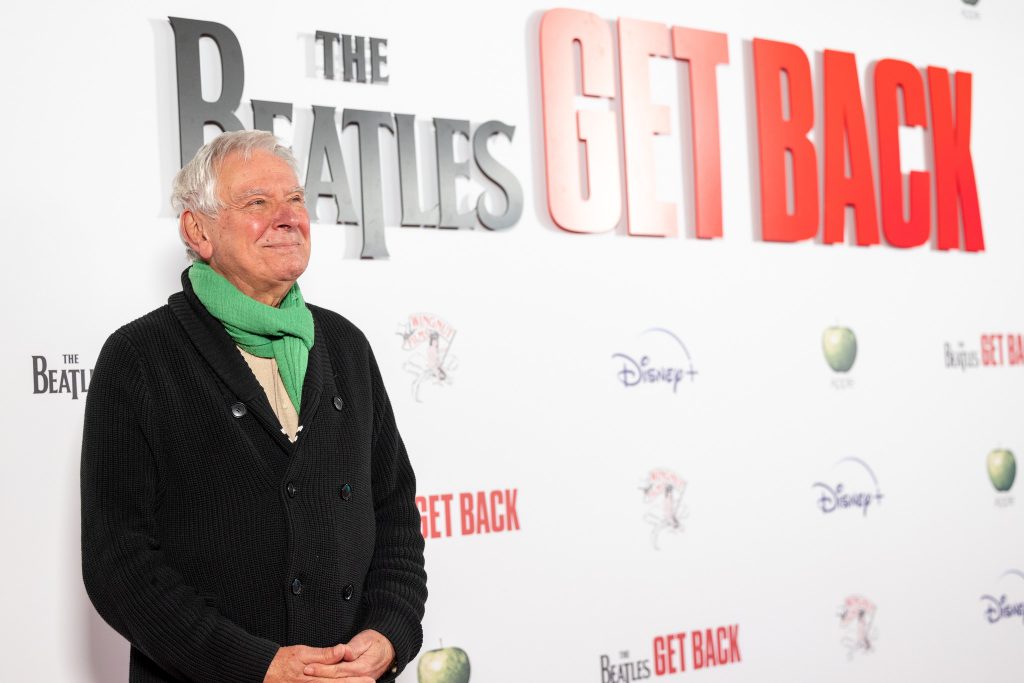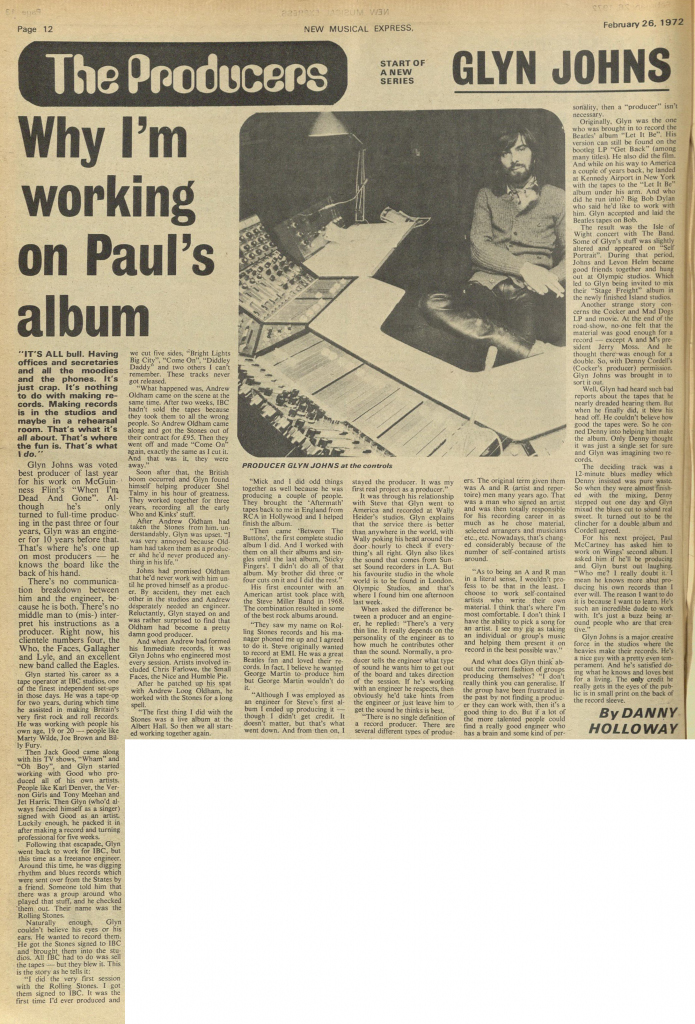Spread the love! If you like what you are seeing, share it on social networks and let others know about The Paul McCartney Project.
About
From Wikipedia:
Glyn Thomas Johns (born 15 February 1942) is an English musician, recording engineer and record producer. […]
Career in recording
Johns produced and/or engineered with artists such as Led Zeppelin, The Rolling Stones, the Beatles (Get Back Sessions), The Who, Eagles, Bob Dylan, Linda Ronstadt, Johnny Hallyday, the Band, Eric Clapton, the Clash, Ryan Adams, the Steve Miller Band, Small Faces, Spooky Tooth, the Easybeats, the Ozark Mountain Daredevils, Blue Öyster Cult, Emmylou Harris, Midnight Oil, New Model Army, Belly, Joe Satriani, Ronnie Lane, Rod Stewart with Faces, John Hiatt, Joan Armatrading, Buckacre, Gallagher and Lyle, Georgie Fame, Family, Helen Watson, Fairport Convention, Humble Pie, and many others.
In 1969, Led Zeppelin paid tribute to Johns by including a photo of actress Glynis Johns on the cover of Led Zeppelin II. The cover was based on a World War I era photo. The Beatles referred to Johns as “Glynis” several times during the Get Back sessions.
In the 1960s, while associated with the UK rock band The Presidents, Johns began working as a recording studio engineer at IBC Studios in Portland Place, London and was able to take the band in during weekends and try his skills at production and recording. The Presidents was his first true production work and in 1969, Johns was called upon to rescue the troubled Get Back sessions for The Beatles. Johns compiled several versions of the album, which were all rejected by the band, before the project was eventually turned over to producer Phil Spector. Spector’s version became the released album, which was retitled Let It Be which Johns called “a syrupy load of bullshit”. […]
Glyn Johns recorded the “Get Back” sessions for The Beatles in January 1969.
It was funny actually. I got a phone call from someone with a Liverpudlian voice and I thought it was Mick Jagger taking the piss. Anyway, it was Paul McCartney. And you don’t turn down Paul McCartney. The idea was something like [Bob Dylan and The Band’s] The Basement Tapes, to show what they were really like. I’d worked with everyone and their mother by then, so I was quite used to being around people who were famous. But when I got the call, to walk in and be privy to those guys sitting around, doing what they did, and to be invited in, was pretty astonishing. I didn’t know them. I was the same as every other punter on the planet, who saw them as these extraordinary icons of marvellousness.
And although they could hardly be normal people, because of what their success had done to them, I was witnessing them being normal to each other. Which no one else had got to see, and which nobody really had a clue about. And so my concept of the record was: how fantastic to have a record of them playing live, sitting around mocking each other, just having a laugh. It was very weird. But George Martin, being the gentleman that he is, he realised that I had been compromised in a way, and he saw fit to put me at ease about the situation. He took me to lunch, and he said, “You’re not to worry about a thing.” I was feeling really awkward about the whole thing, and he was completely at ease about the situation. Because he is confident of his own abilities.
Glyn Johns – From “And In The End” by Ken McNab, and quoted in Classic Rock, May 2020
In March 1969, he was then asked by Paul McCartney and John Lennon to create an LP from those sessions.
On the 1st of May 1969 [Sic – March instead ?], I got a call from John and Paul asking me to meet them at Abbey Road. I walked into the control room and was confronted by a large pile of multitrack tapes. They told me that they had reconsidered my concept for the album that I had presented to them in January and had decided to let me go ahead and mix and put it together from all the recording that we had done at Savile Row. I was thrilled at the idea and asked when they would be available to start. They replied that they were quite happy for me to do it on my own as it was my idea. I left feeling elated that they would trust me to put the album together without them, but soon realized that the real reason had to be that they had lost interest in the project.
Glyn Johns – From “Sound Man: A Life Recording Hits with The Rolling Stones, The Who, Led Zeppelin, the Eagles , Eric Clapton, the Faces…”, 2014
We finish [some of the early sessions for] “Abbey Road”, a period of time goes by, and I get a call from John and Paul. They asked me to meet them at Abbey Road, so I jump in the car and go up there. I walk in the control room and there’s a pile of multi-track tapes and they said “Do you remember the idea that you had, that you had made acetates on?”. So i said “Yeah”. So they said “Well, we think that’s probably the best way to do the record and we’d like you to do it”. “That’s fantastic, great!”. So I said “Well, when did we start?” and they said “Well, we don’t start, you’re going to do it on your own, like you did before”. And I thought “Well that’s fantastic, they’ve got all this confidence in me to go away and do this without them there”. And in the car on the way home, I thought “hold on a minute, it wasn’t anything to do with that, they were bored rigid with it and they weren’t interested anymore, they’d lost interest so they were quite happy to just give it to me, to go away and do”. Which was a bit disappointing really, so it did get finished and I did deliver it back to EMI and then the band broke up.
Glyn Johns – From Glyn Johns talks Beatles, Michael Lindsay Hogg and Let It Be – YouTube, December 2021
The extraordinary thing is that [The Beatles] proved up to that point that they were the masters of the “Produced Record”, yet the stuff I did with them wasn’t “produced” in that way at all, it was all recorded live in a room, in a rehearsal situation. And for that, I think it has great value, because I originally put together an album of rehearsals, with chat and jokes and bits of general conversation in between the tracks, which was the way I wanted [‘Get Back’] to be – breakdowns, false starts.
Really, the idea was that at the time, they were viewed as being the be-all-and-end-all, sort of up on a pedestal, beyond touch, just gods, completely gods, and what I witnessed going on at these rehearsals was that, in fact, they were hysterically funny, but very ordinary people in many ways. And they were capable of playing as a band, which everybody was beginning to wonder about at that point, because they hadn’t done so for some time – everything had been prepared in advance, everything had been overdubbed and everything. And they proved in that rehearsal that they could still sing and play at the same time, and they could make records without all those weird and wonderful sounds on them.
I got the bit between my teeth about it, and one night, I mixed a bunch of stuff that they didn’t even know I’d recorded half the time – I just whacked the recorder on for a lot of stuff that they did, and gave them an acetate the following morning of what I’d done, as a rough idea of what an album could be like, released as it was. There was one thing that only happened once, a song that Paul played to the others, which I believe he later used on one of his ensuing albums, called “Teddy Boy”, and I have a tape of Paul actually teaching the others this song. I loved it, and I was hoping they’d finish it and do it, because I thought it was really good. But my version does go on a bit, and they’re just going round and round, trying to get the chord sequence right, I suppose, and the best bit is where John Lennon gets bored – he obviously doesn’t want to play it anymore, and starts doing his interjections. They came back and said they didn’t like it, or each individual bloke came in and said he didn’t like it, and that was the end of that.
Glyn Johns – From “And In The End” by Ken McNab
Glyn Johns also participated in some of the early sessions for the “Abbey Road” album.
Glyn Johns participated in the initial sessions for Wings’ album, Red Rose Speedway, recorded in 1972; but left after a few weeks. Among the reasons, the fact that everyone in the studio heavily smoke pot, or simply that Paul in reality didn’t want to be bothered by a producer.
One evening they (Seiwell and Laine – author’s note) said, “We’re not happy with you as a producer. You’re not taking any interest in what we are doing”. I said, “If you think that everything you do is a gem of marvelous music, you’re wrong. And if you want to sit and play shit and get stoned for a few hours […] don’t expect me to record everything you’re doing, because frankly it’s a waste of tape and it’s a waste of my energy.
Glyn Johns, in FAB, an Intimate Life of Paul McCartney
He and Paul didn’t hit it off at all. Paul always likes to be his own producer anyway, but at least if he’s going to bring one in they’ve got to be able to see Paul’s point of view.
Denny Laine, in Blackbird: The Life and Times of Paul McCartney
The day after I finished with The Eagles, I went straight in with Paul McCartney and Wings to cut the Red Rose Speedway album, which I quit in a puff of steam after a couple of weeks, and then went straight on to work with Ronnie Lane and Ronnie Wood on the soundtrack to the movie Mahoney’s Estate, with our friend, the actor and director Alexis Kanner.
Glyn Johns, in SOUND MAN, 2014


Last updated on July 5, 2023
Albums, EPs & singles which Glyn Johns contributed to
Get Back / Don't Let Me Down (UK - Mono)
By The Beatles • 7" Single
Contribution: Engineer, Recording engineer • 2 songs
Get Back / Don't Let Me Down (US - Stereo)
By The Beatles • 7" Single
Contribution: Engineer, Recording engineer • 2 songs
My Dark Hour / Song For Our Ancestors
By The Steve Miller Band • 7" Single
Contribution: Producer, Recording engineer • 1 songs
Let It Be / You Know My Name (Look Up The Number)
By The Beatles • 7" Single
Contribution: Recording engineer • 1 songs
The Long and Winding Road / For You Blue
By The Beatles • 7" Single
Contribution: Recording engineer • 2 songs


Contribute!
Have you spotted an error on the page? Do you want to suggest new content? Or do you simply want to leave a comment ? Please use the form below!